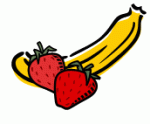I was sifting through some old notes and I found this. No idea in where I got it from, but it is good information:
10 Foods You Should Avoid
Hydrogenated Fats
These are mostly man-made fats that are used in bakery items and stick margarine. Studies show that it isn’t so much how much fat there is in your diet that causes problems, as what kind of fat, and hydrogenated fats are the worst. Avoid buying cookies, crackers, baked goods or anything else that has hydrogenated oil on the ingredient list. Fortunately, the FDA now requires that food manufactures identify the amount of hydrogenated fats in their products—look for trans fats on the nutrition panel.
Olestra
Olestra is a fake fat, used to make non-fat potato chips and other snacks. You’d think, with all the bad rap fat has gotten, a non-fat fat would be great. But Olestra has been shown to bind with fat-soluble vitamins A, E, D and K and carotenoids—substances thought to keep the immune system healthy and prevent some cancers—and to eliminate them from your system. Proctor and Gamble, the company that produces olestra, has acknowledged the problem with vitamins A, E, D and K and is now fortifying it with them.
Olestra has also caused digestive upset in some people, especially when they eat a lot of it. Often, it’s not just fat in the potato chips that causes problems for people; it’s the fact that they are displacing healthier foods, such as fruit, so Olestra can just perpetuate an unhealthy habit.
Nitrates
Many foods, especially cured meats such as bacon and hot dogs, use nitrates to preserve color and maintain microbial safety. Nitrate is harmless, but it can convert to nitrite, which can form nitrosamines, a powerful cancer-causing chemical, in your body. Whenever possible, look for nitrate-free preserved meats. When you do eat foods containing nitrates, have a glass of orange juice at the same time (for instance, orange juice with your morning bacon). Vitamin C is known to inhibit the conversion to nitrosamines in your stomach.
Alcohol
This one item has created more problems than all the rest put together. Of course, it is possible to consume alcohol wisely and safely and enjoy it immensely, such as a fine glass of wine with a delicious dinner. But even if you exercise caution in no other area of your diet, this is the area where you should.
Raw Oysters
Raw oysters can carry deadly bacteria that can cause severe illness or death. Because it is strictly “buyer beware” when buying them, you take a big risk every time you do. To date, no government or independent body inspects seafood for safety or will guarantee its quality. Oysters are a nutritious food, and are great to include in your diet, but if you do, cook them first!
Saturated Animal Fats
That means fatty meats, especially beef and pork, or the skin on poultry. It also includes full-fat dairy products such as cheese, milk and cream. Fatty meat and dairy products do have some contributions to make to a diet, but none that can’t be found elsewhere.
Soda
Drinking soda is a poor way to get fluids. They are full of sugar or artificial sweeteners and often contain caffeine, artificial colors and flavors. Substitute homemade soda by mixing sparkling water with fresh, 100 percent juice.
Low-acid home-canned Foods
Home canning can be dangerous for foods low in acid such as green beans, carrots or other garden vegetables. The potential of botulism is high because home canners often do not reach the temperatures and pressures necessary to kill the botulism spores that may contaminate the food. Low-acid home-canned foods are one of the main causes of food poisoning.
High-fat Snacks, chips
Even if they are made with vegetable oil, they should be minimized. The balance of fat in our diets has shifted too far to the omega-6 variety, found in most processed vegetable oils. It is thought that too many of these fats may be leading to certain chronic diseases. Instead, focus on fruits and non-fat whole grains for snacking.
Liquid meals
They aren’t inherently bad for you, but they do keep you from eating whole, natural foods that contain more nutrients and fiber and disease-fighting phytochemicals. They may be okay for people who are too sick to eat, but don’t let them displace the real foods in your diet.












 bowl and a banana and strawberries in another bowl and each bowl consisted of 150 calories. As you might conclude the bananas and strawberries are far more nutrient dense and supplies us with more nourishment per calorie.
bowl and a banana and strawberries in another bowl and each bowl consisted of 150 calories. As you might conclude the bananas and strawberries are far more nutrient dense and supplies us with more nourishment per calorie. 
